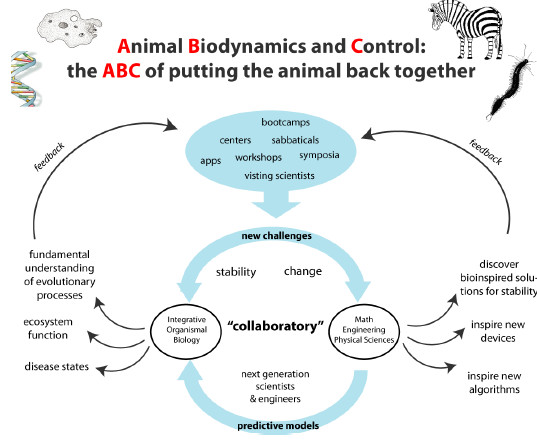SICB Annual Meeting 2014
January 3-7, 2014
Austin, TX
Symposium: A New Organismal Systems Biology: How Animals Walk the Tightrope between Stability and Change.
This symposium will highlight recent efforts to develop a research agenda to address the Organismal Grand Challenge of “How metazoans walk the tightrope between stability and change”. We believe that effectively solving this Grand Challenge will require a transformation in the way that organismal animal biologists approach their discipline. After decades of research, we still lack understanding of what characteristics of complex living systems allow change in response to either internal or external environments, and what characteristics create inflexibility. To comprehend the dynamics of complex living systems, we must move beyond the traditional approaches of organismal biology, and incorporate methodological tools of other disciplines that also study complex systems, particularly mathematics, engineering, and physics. Not only will we gain a deeper, mechanism-based understanding of how organisms will face future environmental challenges, but in pursuing this research endeavor, we will also reveal nature-inspired solutions to stability and agility of exceedingly complex systems. Increased dialog between different fields and collaborations across disciplines will be needed to create the Organismal Systems Biology needed to address this and other Organismal Grand Challenge questions.

Sponsors: SICB Society-Wide
Organizers
- Dianna K. Padilla
- Billie Swalla
- Brian Tsukimura
Speakers
S6.0 Sunday, Jan. 5, 08:15 PADILLA, DK*; SWALLA, BJ; TSUKIMURA, B:
A New Organismal Systems Biology: How Animals Walk the Tightrope Between Stability and Change
S6.1-2 Sunday, Jan. 5, 09:00 HALE, M. E. :
Stability and change in the development of movement systems: Meeting short-term functional demands of the early life history and long-term needs for growth and maturation to the adult form.
S6.1-3 Sunday, Jan. 5, 09:30 SMITH, J.*; COSENTINO, C.:
Reliability and Modularity in the Sea Urchin Gene Regulatory Network for Endomesoderm Specification
S6.2-1 Sunday, Jan. 5, 10:30 BAGHERI, N:
Computational analysis of signaling data elucidates dynamic regulatory networks that govern complex cellular responses.
S6.2-2 Sunday, Jan. 5, 11:00 GRUNBAUM, D.*; PADILLA, D.K.:
SCALES OF ENVIRONMENTAL CHANGE, ENVIRONMENTAL MATCHING AND THE DYNAMICS OF PHENOTYPIC PLASTICITY
S6.3-1 Sunday, Jan. 5, 13:30 NIJHOUT, H.F.*; REED, M.C.:
Homeostasis and dynamic stability of the phenotype: Implications for understanding the nature and evolution of robustness and plasticity
S6.3-2 Sunday, Jan. 5, 14:00 GREENLEE, Kendra J.*; MONTOOTH, Kristi L.:
Predicting performance and plasticity in the development of respiratory structures and metabolic systems
S6.3-3 Sunday, Jan. 5, 14:30 COWAN, N. J.*; DANIEL, T. L.:

